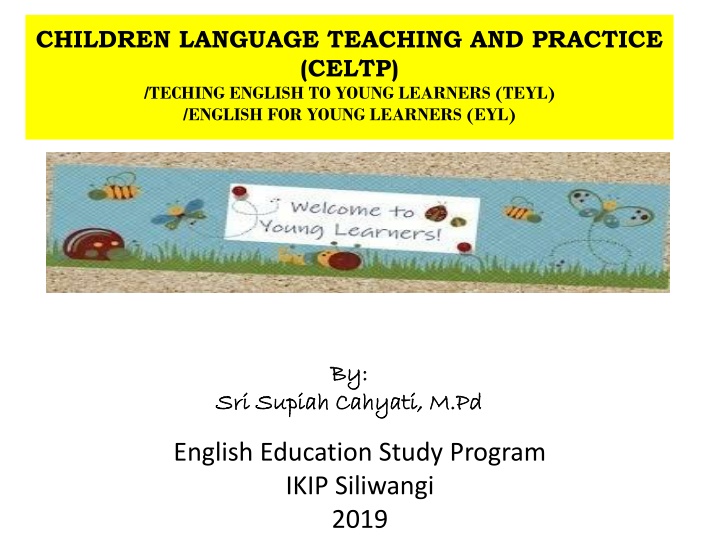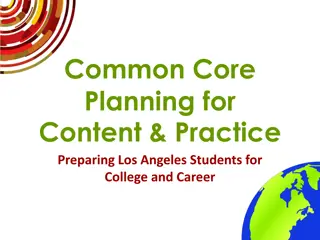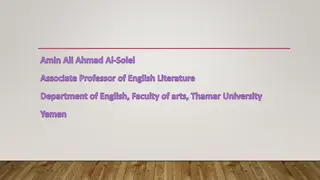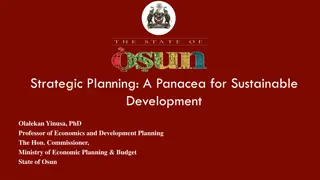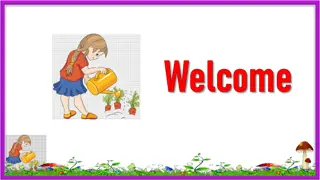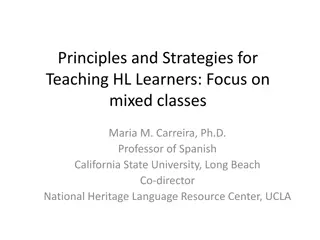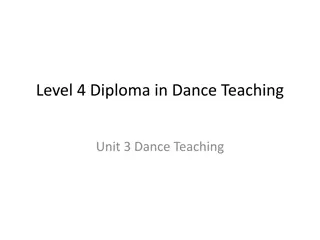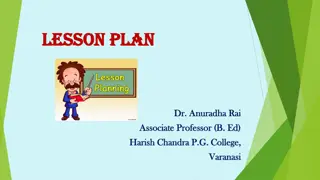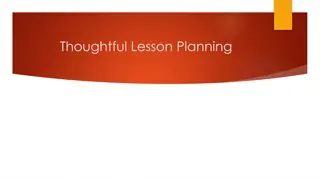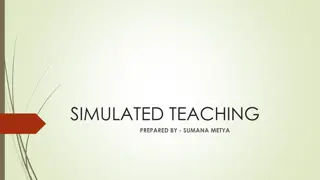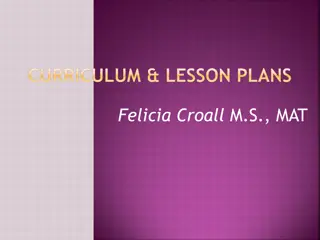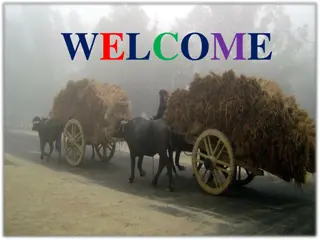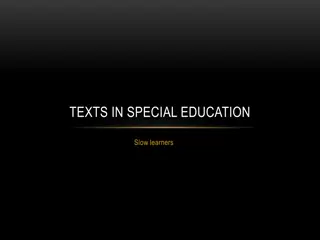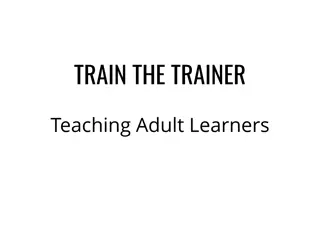Effective Lesson Planning for Teaching English to Young Learners (EYL)
Enhance your teaching skills by learning how to plan engaging and effective lessons for young learners in English language education. Explore the importance of coherence, variety, child-centered learning, teacher-centered approaches, potential challenges, and successful strategies. Gain insights on creating a structured lesson framework that promotes active learning and student engagement.
Download Presentation

Please find below an Image/Link to download the presentation.
The content on the website is provided AS IS for your information and personal use only. It may not be sold, licensed, or shared on other websites without obtaining consent from the author.If you encounter any issues during the download, it is possible that the publisher has removed the file from their server.
You are allowed to download the files provided on this website for personal or commercial use, subject to the condition that they are used lawfully. All files are the property of their respective owners.
The content on the website is provided AS IS for your information and personal use only. It may not be sold, licensed, or shared on other websites without obtaining consent from the author.
E N D
Presentation Transcript
CHILDREN LANGUAGE TEACHING AND PRACTICE (CELTP) /TECHING ENGLISH TO YOUNG LEARNERS (TEYL) /ENGLISH FOR YOUNG LEARNERS (EYL) By: By: Cahyati, , M.Pd Sri Sri Supiah Supiah Cahyati M.Pd English Education Study Program IKIP Siliwangi 2019
How to plan Lesson? Lesson plan gives the lesson framework, an overall shape. Good teachers are flexible and respond creatively to what happens in the classroom, but they also need to have thought ahead, have a destination they want their students to reach, and know how they are going to get there. What are the aims of a plan? a good plan needs to reflect coherence and variety
Students can see a logical pattern to the lesson Coherence A good Lesson plan There has to be some variety in a lesson period Variety The ideal compromise is to plan a lesson that has an internal coherence but which nevertheless allows the students to do different things.
A number of important questions before teacher starts to plan an activity: Why do you want to do it? What will it achieve? How long will it take? What might go wrong? What will you need to do it?
A Lesson Plan of TEYL (Paul, 2003) Child-centered Learning: Noticing Wanting Challenging/taking a risk Playing/experimenting Succeeding Linking/Internalization
Teacher-centered Child-centered We can plan a lesson carefully We can use time effectively We can teach clearly and logically The children behave well and do not chat so much. The children enjoy themselves They learn naturally and actively They are spontaneous Their eyes shine brightly
What can go wrong? We do not give the children space to notice They do what we want them to do They do not try for themselves They do not experiment enough They are unsuccessful They do not make links
Planning a Lesson Preparation From familiar to unfamiliar Varying the focus Varying the style Moving on to the next target
Techniques - Repetition - Introducing new words - Introducing new patterns - Creating a need
Organization One-to-one, pairs, and groups Routines Scoring systems Homework
LEARNING CONDITIONS Plenty of exposure Lots of repetition and routine Friendly environment No compulsion of communication based on desire Unlimited time Parent and child do things together
Sample of Lesson plan 1. Goal : students will increase their familiarity with past tenses, word formation and time expression. 2. Skills: speaking and writing 3. Objectives: Students will comprehend a simple sentence in past tense (T elicits using pictures, invites, and introduces the past tense verbs) Students will identify past tense verbs and try to memorize some (pair work/group work board game) Students will comprehend and produce verbs-studied and necessary vocabulary in past tense (speaking activity) Students will comprehend the word formation of past tense and they are able to make in written form(exercises from workbook/student s book) Homework 4. Materials and Equipment: pictures, worksheets, books. 5. Duration/Time: 90 minutes
Quickie Procedure/Scenario: 1. 2. 3. 4. Opening: Greeting.. Chit chat Review previous lesson (5 ) Checking (5 ) Intro new materials elicit some pictures, cards, board rush etc (10 ) Past tense Board game (group work) test them (15 ) T invites the questions (drill/repetition) (10 ) Worksheet 1 (speaking worksheet-pair work) (10 ) Worksheet 2 (all students are involved-Mingle) (10 ) Do and check the exercise Std Bk page.? (15) 10. Review (10 ) 11. Home work (SB/WB exercises) + Closing NB: Back up activities: Bingo/ any games 5. 6. 7. 8. 9.
8 8 Old Mc Donald s Farm (1) Old Mc Donald s Farm (1) Old Mc Donald had a farm (ee i ee i oh) Old Mc Donald had a farm (ee i ee i oh) And on his farm he had a duck (ee i ee i oh) And on his farm he had a duck (ee i ee i oh) With a quack quack here and a quack quack there With a quack quack here and a quack quack there Here quack there quack Here quack there quack Everywhere a quack quack Everywhere a quack quack Old Mc Donald had a farm (ee i ee i oh) Old Mc Donald had a farm (ee i ee i oh)
8 8 Old Mc Donald s Farm (2) Old Mc Donald s Farm (2) Old Mc Donald had a farm (ee i ee i oh) Old Mc Donald had a farm (ee i ee i oh) And on his farm he had a cow (ee i ee i oh) And on his farm he had a cow (ee i ee i oh) With a moo moo here and a moo moo there With a moo moo here and a moo moo there Here moo there moo Here moo there moo Everywhere a moo moo Everywhere a moo moo Quack quack here and a quack quack there Quack quack here and a quack quack there Here quack there quack Here quack there quack Everywhere a quack quack Everywhere a quack quack Old Mc Donald had a farm (ee i ee i oh) Old Mc Donald had a farm (ee i ee i oh)
8 8 Old Mc Donald s Farm (3) Old Mc Donald s Farm (3) Old Mc Donald had a farm (ee i ee i oh) Old Mc Donald had a farm (ee i ee i oh) And on his farm he had a pig (ee i ee i oh) And on his farm he had a pig (ee i ee i oh) With an oink oink here and an oink oink there With an oink oink here and an oink oink there Here oink there oink Here oink there oink Everywhere an oink oink Everywhere an oink oink Moo moo here and a moo moo there Moo moo here and a moo moo there everywhere moo moo everywhere moo moo Quack quack here and a quack quack there Quack quack here and a quack quack there Everywhere quack quack Everywhere quack quack Old Mc Donald had a farm (ee i ee i oh) Old Mc Donald had a farm (ee i ee i oh)
8 8 Old Mc Donald s Farm (4) Old Mc Donald s Farm (4) Old Mc Donald had a farm (ee i ee i oh) Old Mc Donald had a farm (ee i ee i oh) And on his farm he had a turkey (ee i ee i oh) And on his farm he had a turkey (ee i ee i oh) With a gobble gobble here and a gobble gobble there With a gobble gobble here and a gobble gobble there Here gobble there gobble Here gobble there gobble Everywhere a gobble gobble Everywhere a gobble gobble oink oink here and oink oink there oink oink here and oink oink there Here an oink there an oink Here an oink there an oink Everywhere an oink oink Everywhere an oink oink Moo moo here and a moo moo there Moo moo here and a moo moo there here moo there moo here moo there moo everywhere moo moo everywhere moo moo Quack quack here and a quack quack there Quack quack here and a quack quack there here quack there quack here quack there quack Everywhere quack quack Everywhere quack quack Old Mc Donald had a farm (ee i ee i oh) Old Mc Donald had a farm (ee i ee i oh)
Bland, Janice (ed.) (2015). Teaching English to Young Learners: Critical Issues in Language Teaching with 3-12 Year Olds. London: Bloomsbury Publishing Plc. Brewster, Jean; Ellis, Gail; Grard, Dennis. (2003). The Primary English Teacher s Guide (New Edition). England: Penguin English. Cameron, L. (2001). Teaching Languages to Young Learners. Cambridge: Cambridge University Press. Damayanti, Ika Lestari. (2017). From Story Telling to Story Writing: The Implementation of Reading to Learn (R2L) Pedagogy to Teach English as a Foreign Language in Indonesia. Indonesian Journal of Applied Linguistics vol. 6 no. 2, January 2017, pp. 229-242. Fadilah, Rahmi. (2017). Madeline Hunter s Lesson Plan as Alternative Model for TEYL. Proceedings in English Conference at STKIP Pasundan. Garton, Sue & Copland, Fiona (ed.). (2019). Teaching English to Young Learners. New York: Routledge. Halliwell, S. (2004). Teaching English in the primary classroom. Essex: Pearson Education Limited. Harmer, Jeremy. (2004). How to Teach English: An Introduction to the Practice of English Language Teaching. England: Longman. Harmer, Jeremy. (2007). How to teach English (New Edition). Essex: Pearson Longman. Ioannou-Georgiou, Sophie & Pavlou, Pavlos. 2003. Assessing Young Learners. Oxford: Oxford University Press. Linse, Caroline T. (2005). Practical English Language Teaching: Young McGraw-Hill. Learners. New York:
Mckay, P. (2006). Assessing young language learners. Cambridge: Cambridge University Press. Mooney, Carol Garhart. (2000). Theories of Childhood: An Introduction to Dewey, Montessori, Erikson, Piaget, and Vygotsky. USA: Redleaf Press. Musthafa, Bachrudin. (2000). Teaching English to Young Learners: Techniques. Bandung: Pasca Sarjana Universitas Pendidikan Indonesia. Mustafa, Bachrudin. (2008). Teaching English to young learners. Bandung: UPI Press. Mustafa, Bachrudin. (2010). Teaching English to young learners in Indonesia: Essential requirements. Jurnal Educationist.Vol. 4 no.2, Juli 2010 pp. 120-125. Paul, David. (2003). Teaching English to Children in Asia. Hongkong; Longman Asia ELT. Pinter, Annamaria. (2006). Teaching Young Language Learners. Oxford: Oxford University Press. Slattery, M. & Willis, J. (2005). English for Primary Teachers: A Handbook of Activities and Classroom Language. Oxford: Oxford University Press. Youtube Principles &
